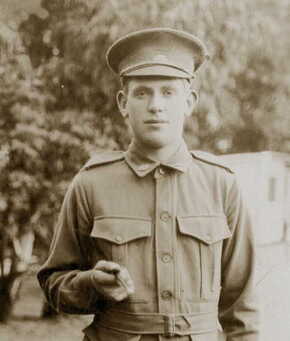
STEVENS, Edward William
| Service Number: | 734 |
|---|---|
| Enlisted: | Not yet discovered |
| Last Rank: | Corporal |
| Last Unit: | 40th Infantry Battalion |
| Born: | Upper Castra, Tasmania, Australia, 14 May 1894 |
| Home Town: | Upper Castra, Central Coast, Tasmania |
| Schooling: | Upper Castra State School, Tasmania, Australia |
| Occupation: | Labourer |
| Died: | Killed in action, France, 28 March 1918, aged 23 years |
| Cemetery: |
Heilly Station Cemetery Plot VII, Row A, Grave No. 34. |
| Memorials: | Australian War Memorial Roll of Honour, Ulverstone Shrine of Remembrance |
World War 1 Service
| 1 Jul 1916: | Involvement Private, 734, 40th Infantry Battalion, --- :embarkation_roll: roll_number: '18' embarkation_place: Hobart embarkation_ship: HMAT Berrima embarkation_ship_number: A35 public_note: '' | |
|---|---|---|
| 1 Jul 1916: | Embarked Private, 734, 40th Infantry Battalion, HMAT Berrima, Hobart | |
| 28 Mar 1918: | Involvement Corporal, 734, 40th Infantry Battalion, --- :awm_ww1_roll_of_honour_import: awm_service_number: 734 awm_unit: 40th Australian Infantry Battalion awm_rank: Corporal awm_died_date: 1918-03-28 |
Help us honour Edward William Stevens's service by contributing information, stories, and images so that they can be preserved for future generations.
Add my storyBiography contributed by Stephen Brooks
Edward William Stevens was the son of John and Mary Ann Stevens, of Upper Castra, Tasmania. At five foot ten and 12 stone he was a solidly built young soldier, only 21 years of age when he enlisted.
Upper Castra is a farming district in Tasmania approximately 20 kilometres south of Ulverstone. There is no village as such today, just a number of farm buildings and homes scattered alongside the road.
He was awarded a Military Medal after only a few months at the front.
'At Armentieres on the night 12th/13th April, 1917, on the occasion of a heavy bombardment of our lines and on an attempted enemy raid on our trenches, this man was No. 1 of a Lewis gun team, which was largely responsible for the repelling of the raid. He displayed conspicuous gallantry and coolness under fire in the working of his gun, and in repairing a breakdown in the midst of the heavy bombardment - and rapidly as to be able to bring the gun again to bear on the enemy. His devotion to duty set a splendid example to the men of his team.'
In Tasmania the local paper reported later in 1917, “Corporal E. W. Stevens, has been admitted to Graylingwell War Hospital, Chilchester, England, suffering from gas poisoning. The letter says that the case is a mild one, . which is of course very satisfactory to the parents of this gallant soldier, who is credited with performing one of those acts of bravery which brought him prominently under official notice, and for which he has been awarded the Distinguished Conduct Medal. Corporal Stevens left Tasmania with the 40th Battalion, and has been at the front for about 12 months. The act for which he received the distinction is said to have been when severely engaged with the enemy; his gun crew were all killed, and when left alone he kept working the gun, and succeeded in keeping the enemy at bay for six hours until relieved.”
Edward was wounded with gas poisoning at Messines during June 1917 and had to recuperate in England for several months. He was killed in action on 28 March 1918, when the 40th Battalion made an advance. Although successful the battalion lost 34 men killed during the operation, nearly all of whom are buried in the Heilly Station Cemetery.










